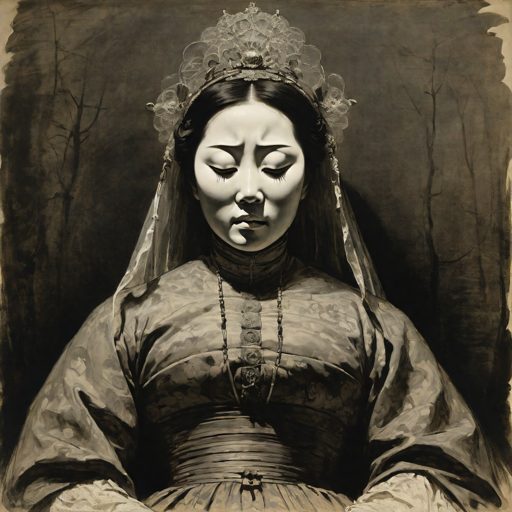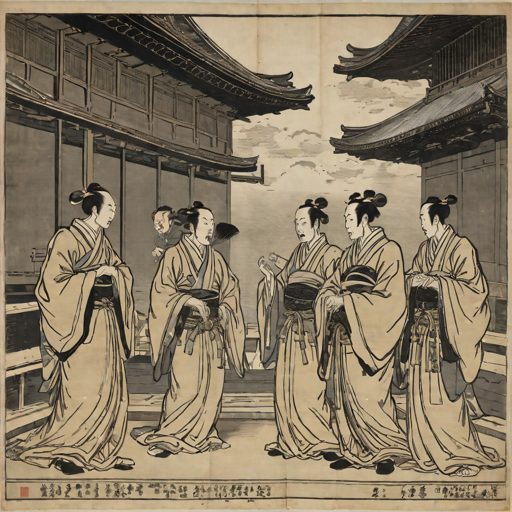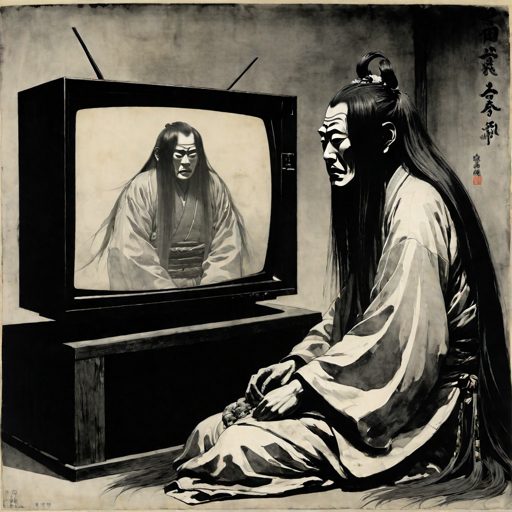
The Art of the Spectral: Exploring The Ghosts of Kabuki
Recommended for Secondary Grades
The Ghosts That Linger
In a hidden corner of the National Museum of Asian Art, the air hangs heavy, almost expectant. Even amidst the quiet bustle of visitors, a strange silence descends upon this particular collection. Here, haunting images whisper tales of restless specters and lingering spirits.
Each colorful woodblock print, vibrant yet chilling, is a gateway to a centuries-old fascination with the otherworldly. An enduring obsession with the ghosts of Japan!
The prints hum with a strange energy. The colors seem too bright, the figures too expressive. It’s as if the artists trapped something within the ink and paper—a feeling that prickles the back of your neck, whispers of a presence just beyond your sight.
The Story of Oiwa

The Story of Oiwa
Among these spectral visions, one figure chills the very air around it: Oiwa, the betrayed wife whose tortured spirit returned to torment her murderer. Close your eyes, and picture her – once a vision of delicate beauty, her features now distorted into a monstrous mask of suffering.
Her skin, once the flush of life, is now the ghostly pallor of moonlight on a tomb.
Imagine her disfigured face, a testament to the cruelty she endured. Each grotesque line tells a story of poison and betrayal. Her ghostly form rises from the shadows, not in fury, but in chilling supplication.
She seeks not vengeance, but a terrible acknowledgment.
Her eyes, hollow and haunted, bore into yours, asking a question that echoes through the centuries: can such monstrous deeds truly go unpunished?
Like many ghosts of Japanese lore, Oiwa isn’t evil, simply…unfinished. She lingers as a whisper of sorrow, a chilling reminder that the echoes of wrongdoing can transcend even the boundary of death.
Her presence seeps from the image, an icy touch on your soul.
Specters on Stage
These images were born from a vibrant theatrical tradition centuries old – kabuki, a spectacle of stylized drama, fantastical costumes, and shocking special effects. On the kabuki stage, flames didn’t simply flicker, they crackled and writhed like restless spirits, casting long, dancing shadows that stretched like skeletal fingers across the room.
Trapdoors opened not with a simple creak, but with a chilling wail of rusty hinges, as if the underworld itself groaned in protest.
Apparitions emerged bathed in an otherworldly glow – a sickly green, a mournful blue – their forms shimmering like phantoms against the darkness.
Actors soared through the air, carried by more than wires. It was the shared, breathless belief of the audience that lifted them, that made spectral flight seem momentarily possible.
Here, ghosts didn’t just walk, they slithered and glided, blurring the lines between the living and the dead.
Kabuki was more than just a performance; it was a seance, an invitation for the supernatural to cross the threshold into the world of men. It was a place where audiences, hearts pounding in their chests, could almost feel the icy touch of the other side.
A Ghostly Renaissance

A Ghostly Renaissance
The Edo period thrummed with tales of the supernatural. The air itself crackled with whispered rumors of hauntings and vengeful spirits. Japan’s rigid social structures fueled a desperate thirst for otherworldly justice. In the theater, the ghosts were arbiters, meting out retribution denied to the living by a corrupt world.
Imagine the electricity in the audience – the low hum of anticipation before the curtain rose, the sharp intake of breath as a ghostly figure appeared from the gloom. These weren’t just plays, they were exorcisms of societal ills, dark fantasies given terrifying form on stage.
And as the audience left the theater, eyes darting nervously at shadows, they couldn’t shake the feeling that some echoes of life, some flicker of vengeance, might follow them home.
Prints of the Impossible
Artists preserved these fleeting theatrical illusions in exquisite woodblock prints, but these weren’t ordinary mementos. Each image hummed with an uncanny power, a fragment of the stage’s charged atmosphere.
Intricate patterns swirled, vibrant colors pulsed with otherworldly energy, echoing the shivers that ran through Edo audiences when faced with the spectral.
Some prints were more than mere pictures; they were interactive spells. Hidden flaps whispered of impossible wonders – bodies twisted together in a macabre embrace, the clammy touch of a spirit leaving a gruesome mark on terrified flesh.
These weren’t just tricks; they were portals to another reality. The artists, masters of illusion, seemed to capture whispers of the supernatural within those delicate lines.
Each print was a bottled nightmare, a reminder that the world holds both beauty and uncanny horrors in equal measure.
Why Ghosts Remain
But why? Why this enduring fascination with the otherworldly? Was it mere escapism from the rigid constraints of everyday life? Or was there something deeper, a subconscious reflection of a society in flux?
Just as ghosts are beings perpetually trapped between worlds, the Japan of the Edo period was a nation caught between its ancient traditions and an uncertain future.
Perhaps these chilling tales, painted with such unsettling beauty, offered a strange solace in times of change. They were a reminder that even as the world shifted around them, there were forces beyond human understanding, threads connecting the living to the long departed.
The Ghosts Today

The Ghosts Today
Step away from these ancient images, and their unsettling power lingers, slithering into the cracks of today’s Japan. The long-haired spirit of Ringu, her form flickering on forgotten VHS tapes and cracked phone screens, is a modern incarnation of those vengeful kabuki ghosts.
Her dripping figure, a stark silhouette of vengeance on the glow of technology, testifies to the chilling, timeless power of the unseen.
Even amidst the frenetic pulse of neon cities, under the sweltering heat of summer nights, people gather. They cling together, their whispers barely audible over the urban hum, recounting spine-tingling tales.
It’s a ritual echoing those long-ago theater crowds, a shared yearning to touch the veil of the unknown and savor the delicious shiver of fear.
And who knows, perhaps even now, as your eyes trace these very lines, the spirit of Oiwa is watching. Her form flickers in the corner of your vision, her disfigured face a haunting plea painted in the shadows cast by your screen.
Her presence whispers in the faint static, an insistent reminder that some echoes, some threads of sorrow and injustice, never truly fade.
Curious Times is a leading newspaper and website for kids. We publish daily global news aligned to your learning levels (also as per NEP 2020): Foundational, Preparatory (Primary), Middle and Senior. So, check out the News tab for this. We bring kids’ favourite Curious Times Weekly newspaper every weekend with top news, feature stories and kids’ contributions. Also, check out daily JokesPoke, Tongue Twisters, Word of the Day and Quote of the Day, kids need it all the time.
Curious Times News Program for Schools for FREE. Over 5,000 schools and teachers from all over the world have joined our programme so that students and teachers can get FREE Educative Newspaper. Here, kids can take part in world events and win prizes and certificates for free through their schools.
Moreover, schools are sharing important School News, like interviews with the principal, notices about new students, contests, and results, not just on social media but also on a news website for kids and other schools.
Thus, do not wait any further, sign-up for your school for FREE.
The following social media platforms allow you to communicate with us: WhatsApp, Instagram, Facebook, Youtube, Twitter, and LinkedIn.
0 (Please login to give a Curious Clap to your friend.)
